SAFARI DATES: January 30 – February 7, 2025
ITINERARY | INCLUSIONS | EXCLUSIONS | TERMS & CONDITIONS
THE ANSWER: 12 adventuresome women on an incredible safari WITH Wanderful Tanzania’s Founder (Susie Langley) during Tanzania’s GREEN/BABY season!
With over a decade of leading amazing trips to the most beautiful and interesting places in the world, Susie has created what she calls a “Thrive Tribe” from all of the women who have been on these explorations with her. The deep friendships and close bonds that form between these women provide them with a sisterhood of strength, support, companionship, and memories to last a lifetime. And, in Susie’s fashion, they are all very focused on traveling with the intention of leaving only love, joy, compassion, and good vibrations in their wake.
This is YOUR personal invitation to join the Thrive Tribe too, when you join in on this incredible safari! Susie will be with you every step of the way, so you’re sure to understand exactly how Tanzania stole her heart, stoked her passion, revived her purpose, and has become her beloved home away from home.
THE ANSWER: If you picture a golden lion standing in an endless field of golden grasses blowing in the gentle breeze when you think of Africa, you are not alone! That iconic image is 100% accurate for the majority of people who travel to Tanzania on safari, as the vast majority of those visitors come during high season… which is also dry season (July-September). That is the time of year when the Great Migration herd is crossing the treacherous Mara River in pursuit of the rains and new grasses up in Kenya, to the north.
Now picture that same scene, but imagine your golden lion standing in an endless sea of bright green grasses and wildflowers! Following the short rainy season, Tanzania springs back to life… becoming as green as Ireland from January through March! The volume of tourists is a fraction of what it is during the dry season, and that Great Migration has once again returned to Serengeti’s southern plains in order to give birth to more than 400,000 babies in just a few weeks’ time! Love is in the air, and the babies are bountiful at this time of year!
It is magical to behold, and a photographers dream!
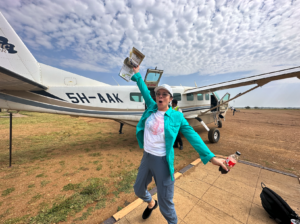 An exhilarating bush flight will take you from the Arusha Airport to the Seronera Airstrip in the central region of the Serengeti National Park, where you’ll meet your safari guide(s) for the first time! They will be there to welcome you to the Serengeti, will help you to get situated in the safari vehicle(s)… and you’ll be off on your first game drive of the safari, straight away!
An exhilarating bush flight will take you from the Arusha Airport to the Seronera Airstrip in the central region of the Serengeti National Park, where you’ll meet your safari guide(s) for the first time! They will be there to welcome you to the Serengeti, will help you to get situated in the safari vehicle(s)… and you’ll be off on your first game drive of the safari, straight away!
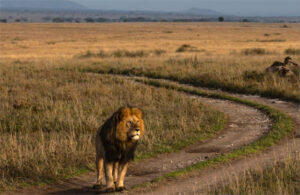 The majestic and world famous Serengeti is the thing that dreams are made of! Granite kopjes (pr. co-pees) pop up, seemingly out of nowhere, and dot the landscape like islands in a sea of breeze-blown grasses.
The majestic and world famous Serengeti is the thing that dreams are made of! Granite kopjes (pr. co-pees) pop up, seemingly out of nowhere, and dot the landscape like islands in a sea of breeze-blown grasses.
The park has a well-earned reputation for reliable and unforgettable wildlife encounters that at times seem to be around every bend in the road! You should have no problem spotting elephants, giraffes, zebras, antelopes of every variety, hippos… and BIRDS! The birds in the parks of Tanzania are nothing short of mind blowing, both in volume and beauty!
 Your next adventure will take place on the Ndutu Plains in the Southern Serengeti. This area was made famous by documentary and cinematic filmmakers, and by researchers such as Jane Goodall.
Your next adventure will take place on the Ndutu Plains in the Southern Serengeti. This area was made famous by documentary and cinematic filmmakers, and by researchers such as Jane Goodall.
The best months to visit the Ndutu Region are from December (when the Great Migration herds start to arrive from the north) until April when the millions of wildebeest, zebra and gazelle have begun their next march northwards once again.
In the early months of the year – with a peak in February – the wildebeest herds are calving on the verdant grassy plains (upwards of 8,000 baby animals are born in this region each day during calving season), which, in turn, also attracts the attention of cheetahs, lions and hyenas. All six of the big cat species can be found in the area all year – lion, leopard, cheetah, caracal, serval and African wildcat.
Lake Ndutu and Lake Masek form shallow basins where water accumulates from the nearby highlands. The water in both lakes are extremely saline… too saline for human consumption. Lake Ndutu comes alive with animals during the migration because it is surrounded by the dense woodlands and short-grass plains, which provide ample cover and food.
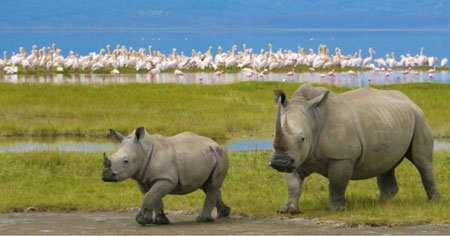 Get a good night’s sleep on Night 6, as the morning of Day 7 will start mighty early! You’ll be thankful to get a very early jump on this day so that you bid farewell to the wide-open plains of the Serengeti and maximize your time on floor of the gorgeous Ngorongoro Crater! It is in that other-worldly wonderland where you’ll be on the lookout to find the 5th element of the Big Five… the endangered Black Rhinos (shown below).
Get a good night’s sleep on Night 6, as the morning of Day 7 will start mighty early! You’ll be thankful to get a very early jump on this day so that you bid farewell to the wide-open plains of the Serengeti and maximize your time on floor of the gorgeous Ngorongoro Crater! It is in that other-worldly wonderland where you’ll be on the lookout to find the 5th element of the Big Five… the endangered Black Rhinos (shown below).
Once the tallest peak on the African continent at a soaring 23,000 ft elevation, the Ngorongoro volcano erupted a couple million years ago, and then collapsed in on itself creating a massive caldera… which we routinely mislabel as a “crater.” The rim of this former giant now stands at just 7,500 feet, and the floor is approximately 5,500 feet in elevation. Lucky for us, the present day caldera is now an incredible, self-sustaining ecosystem, boasting the highest density of African wildlife on Earth, and is a UNESCO World Heritage site to boot! And lucky for Kilimanjaro too, as it now holds the honor of being the highest peak in all of Africa, rising to a height of 19,300 feet above sea level.
Note: The Big Five are Leopard, Lion, Buffalo, Elephant, and Rhino.
Although Tanzania has many wilderness and wildlife show pieces, this one is particularly difficult to put into words. With remarkable views from the ridge above, to the real action on the crater floor, the crater embodies a constant stir of wildlife and unspoiled scenes to keep you engrossed.
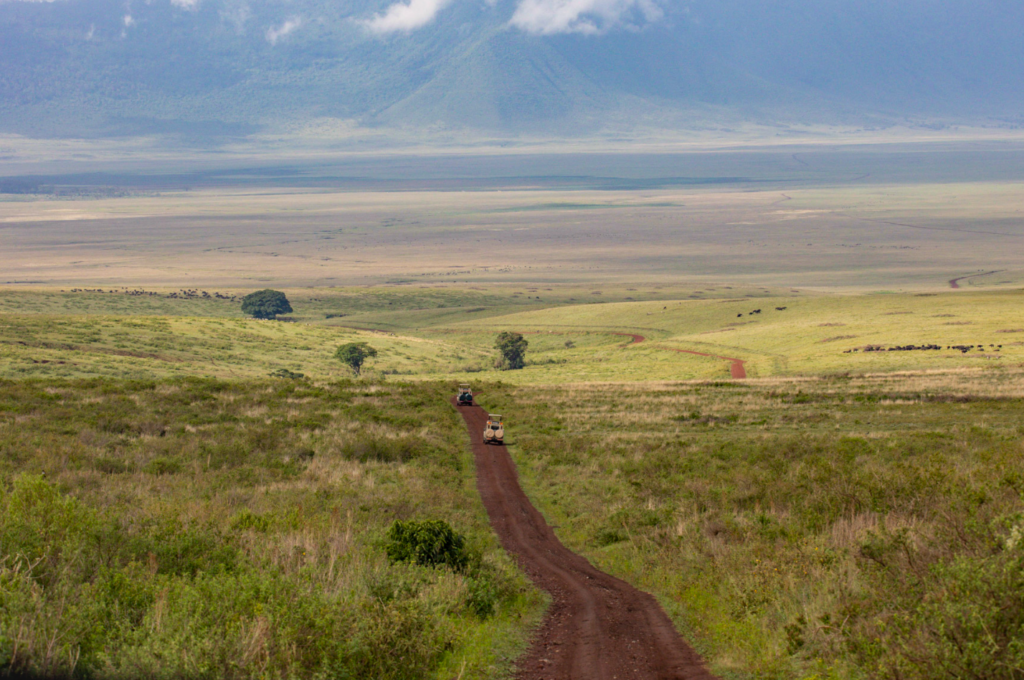 One of our past guests described Ngorongoro as “Where Heaven Meets Earth!” Another said it was like “A mixture of Narnia and Seuss, with just a dash of Jurassic Park!” However YOU describe it, it is a must-see on any Tanzanian safari!
One of our past guests described Ngorongoro as “Where Heaven Meets Earth!” Another said it was like “A mixture of Narnia and Seuss, with just a dash of Jurassic Park!” However YOU describe it, it is a must-see on any Tanzanian safari!
As evening approaches, our guides will bring us safely back to the rim road that encircles the caldera, and then into yet another dramatic scenery change. The side of Ngorongoro mountain that is opposite the Serengeti plains is a lush, verdant greenery bomb. It is not such a jarring change at this time of year, but during the dry season the juxtaposition of vegetation between the plains the tropical side of the mountain is astonishing to behold!
This section of the trip is a complete diversion from the game drives you’ve been doing, and provides a unique opportunity to meet and interact with three different tribal families from two very different tribes that have made their home in this region of Tanzania for hundreds of years (or more).
You will be treated to incredible demonstration so metal work by the wonderful “blacksmith family” of the Datoga tribe. These folks adeptly turn scrap metal into useful weapons and really beautiful and fun jewelry!
The Datoga tribe’s greeting is, “Say you” (hello, essentially).
The blacksmith family is delightful, and they will astonish you with what they can make from a pile of junk metal! You can participate in a good bit of the process, or just sit back and watch the magic!
 While in this area, you’ll also pay a visit to a farming family of the Datoga tribe. This is a family comprised of a 94+ year old patriarch (pictured below), his 10 wives, 50+ kids, and 100+ grandkids. This man is absolutely brilliant to interact with… very funny, genuine, and still sharp as a tack!
While in this area, you’ll also pay a visit to a farming family of the Datoga tribe. This is a family comprised of a 94+ year old patriarch (pictured below), his 10 wives, 50+ kids, and 100+ grandkids. This man is absolutely brilliant to interact with… very funny, genuine, and still sharp as a tack!
The women of the farming family do almost everything in the tribe… farming, ranching, harvesting, grinding, cooking, bearing and raising the kids, beadwork, and dealing with the very few tourists who are lucky enough to get to meet them in person.
It is always polite to ask if you can take photos of them and their children. They will say YES! They love to have their pictures taken, and will then swarm around you to see the pictures on your phone screen!
Feel free to ask them questions about the plural marriage situation, what a day in their life is like, what happens when one of them has a new baby, etc. The interpreter will help you communicate with one another… and they may even start asking you about your lives too!
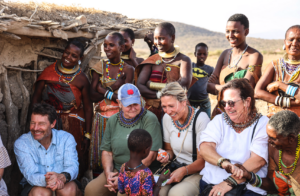 The third group you will meet is perhaps the most special of all… they are the famous Hadzabe Tribe (or Hadza for short). They are the last true hunter/gatherer tribe in all of Africa.
The third group you will meet is perhaps the most special of all… they are the famous Hadzabe Tribe (or Hadza for short). They are the last true hunter/gatherer tribe in all of Africa.
Experts say there are only about 1000 of them left at this point, and that they will likely die out completely in the next couple of decades, as the women are being persuaded to leave the tribe and marry into the Massai tribe for a better lifestyle.
“Say you” will NOT work with these folks. They speak the language that has a lot of clicks and pops in it… so ask your interpreter to help you learn to say “Hello” and “Thank you” in Hadza!
The Hadza hunt nearly every day, just to keep their families fed. They will hunt almost anything from mice and birds to huge antelope… and everything in between. Even with a successful hunt, most of their food each day comes from roots, plants, fruit, and berries that they gather daily. And about 15% of their caloric intake each year is from honey! Honey is also their currency.
Members of the tribe (via your interpreter) will tell you all about their weapons, hunting techniques and traditional ways. They may let you shoot their bows and arrows, or perhaps you’ll be invited to help them make fire! You never know what you’ll get to see or do when you visit these fascinating and warm people!
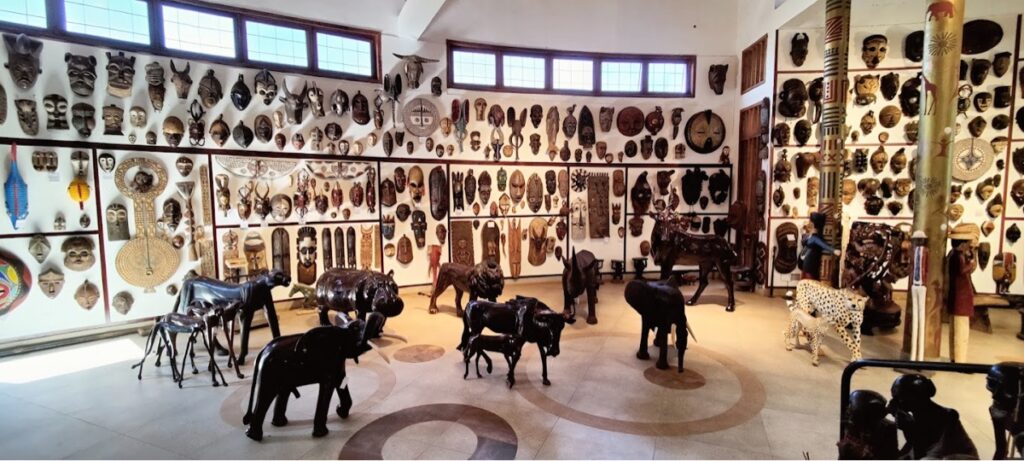 On this final day of safari, our guides will bring our group back to Arusha, with a couple of fun stops along the way. First we will visit the incredible African Galleria for exploration, shopping, and a fantastic East African lunch! During this lunch is the perfect time for guests who wish to offer additional gratuity to the guides to do so. Often the group chooses to pool their tips and I handle the distribution with thank you cards and envelopes for each of our guides.
On this final day of safari, our guides will bring our group back to Arusha, with a couple of fun stops along the way. First we will visit the incredible African Galleria for exploration, shopping, and a fantastic East African lunch! During this lunch is the perfect time for guests who wish to offer additional gratuity to the guides to do so. Often the group chooses to pool their tips and I handle the distribution with thank you cards and envelopes for each of our guides.
Following lunch, we’ll head back to the Arusha/Kilimanjaro area where everyone will have a few hours in a Day-Use room at one of the local safari lodges. You can use this time to nap, shower, repack… or whatever you need to do to prepare for your long flights home this evening.
You’ll bid farewell to your incredible safari guide(s) at the end of what is certain to be an incredible journey. You’ll hug it out in the airport parking lot of the airport… and fair warning… there may be tears!
These guys were complete strangers just 9 short days ago, but now they will be your forever friends. They have shared their knowledge, expertise and passion for Africa’s wilderness with you, and have done all they can to ensure your safari experience was safe, comfortable, and absolutely unforgettable for all the right reasons! As the wheels of your jet lift off from the tarmac, we know that your thoughts and your hearts will be filled with the wonderful memories from your time in Tanzania!

Wanderful Tanzania is an African Safari Tour Company partnership powered by Periquito Adventures & Travel in the USA.
© Copyright 2023 | Wanderful Tanzania | All Rights Reserved | Powered by Periquito Adventures & Travel